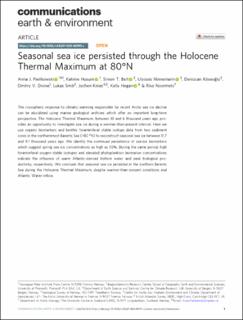| dc.contributor.author | Pieńkowski, Anna J. | |
| dc.contributor.author | Husum, Katrine | |
| dc.contributor.author | Belt, Simon T. | |
| dc.contributor.author | Ninnemann, Ulysses S | |
| dc.contributor.author | Köseoğlu, Denizcan | |
| dc.contributor.author | Divine, Dmitry V. | |
| dc.contributor.author | Smik, Lukas | |
| dc.contributor.author | Knies, Jochen | |
| dc.contributor.author | Hogan, Kelly | |
| dc.contributor.author | Noormets, Riko | |
| dc.date.accessioned | 2021-08-16T10:54:28Z | |
| dc.date.available | 2021-08-16T10:54:28Z | |
| dc.date.created | 2021-06-21T08:18:15Z | |
| dc.date.issued | 2021 | |
| dc.identifier.issn | 2662-4435 | |
| dc.identifier.uri | https://hdl.handle.net/11250/2767969 | |
| dc.description.abstract | The cryospheric response to climatic warming responsible for recent Arctic sea ice decline can be elucidated using marine geological archives which offer an important long-term perspective. The Holocene Thermal Maximum, between 10 and 6 thousand years ago, provides an opportunity to investigate sea ice during a warmer-than-present interval. Here we use organic biomarkers and benthic foraminiferal stable isotope data from two sediment cores in the northernmost Barents Sea (>80 °N) to reconstruct seasonal sea ice between 11.7 and 9.1 thousand years ago. We identify the continued persistence of sea-ice biomarkers which suggest spring sea ice concentrations as high as 55%. During the same period, high foraminiferal oxygen stable isotopes and elevated phytoplankton biomarker concentrations indicate the influence of warm Atlantic-derived bottom water and peak biological productivity, respectively. We conclude that seasonal sea ice persisted in the northern Barents Sea during the Holocene Thermal Maximum, despite warmer-than-present conditions and Atlantic Water inflow. | en_US |
| dc.language.iso | eng | en_US |
| dc.publisher | Nature Research | en_US |
| dc.rights | Navngivelse 4.0 Internasjonal | * |
| dc.rights.uri | http://creativecommons.org/licenses/by/4.0/deed.no | * |
| dc.title | Seasonal sea ice persisted through the Holocene Thermal Maximum at 80°N | en_US |
| dc.type | Journal article | en_US |
| dc.type | Peer reviewed | en_US |
| dc.description.version | publishedVersion | en_US |
| dc.rights.holder | Copyright The Author(s) 2021 | en_US |
| dc.source.articlenumber | 124 | en_US |
| cristin.ispublished | true | |
| cristin.fulltext | original | |
| cristin.qualitycode | 1 | |
| dc.identifier.doi | 10.1038/s43247-021-00191-x | |
| dc.identifier.cristin | 1917109 | |
| dc.source.journal | Communications Earth & Environment | en_US |
| dc.relation.project | Norges forskningsråd: 276730 | en_US |
| dc.relation.project | Miljødirektoratet: 6622/299 | en_US |
| dc.relation.project | Norges forskningsråd: 245907 | en_US |
| dc.relation.project | Norges forskningsråd: 223259 | en_US |
| dc.identifier.citation | Communications Earth & Environment. 2021, 2, 124. | en_US |
| dc.source.volume | 2 | en_US |

